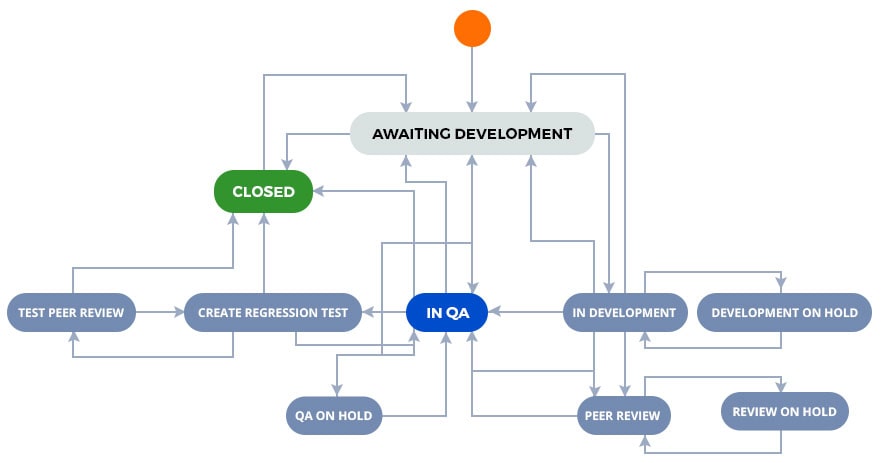Extreme testing: why your team constantly misses the project deadline
by Kate Libbie | December 12, 2019 12:26 pm
Deadlines. Nothing else can motivate and make you work faster and sometimes even at night. What to do when the Scrum, Kanban, and Agile are powerless, but you need to get within the time frame? QATestLab team has tried to figure it out. We analyzed the most common mistakes related to time management and prepared a template on effective QA process. Don’t hesitate and read this post to stay ahead of the curve teams.
Situations at project that interfere with software testing process
Let’s face the reality: we live in a world of imperfect things, and among them, the software testing[1] process is not an exception. Every day QA testers stumble upon a whole slew of obstacles, and the vast majority of them happen due to the wrong approach to work organization.
If you look at the picture more broadly, all the problems concerning the QA testing process can be divided into two categories:
- external risks – outside the control of the team. For example, the product requirements changed, but the client is delaying in providing it – the team is not responsible for this.
- internal risks – faced by a company from within. For example, testers are busy on other projects, the team members are changing or the product has been returned to redo.
One way or another, the second group of risks is more important. When you have no power to correct external risks, you can always change the internal processes and so make your QA team[2] more effective.
Here are the most frequently encountered problems that can affect the timelines of the project (for the worse):
- Fixes, features, “small fixes” are being produced without changing the version. The result is obvious – the version that was considered tested can be fraught with undocumented changes and various regression bugs.
- The version changes and runs after each change. Sometimes the opposite situation occurs when the appearance of each fix is marked by the creation and deployment of a new version. This is acceptable only at the end of testing with a small number of bugs, otherwise, it turns into a continuous stream of versions.
- Changes are uploaded before the end of the current testing cycle. Paragraphs 1 and 2 are often accompanied by an unpleasant side effect: the developer uploads the changes as soon as they are ready, even if the current testing process[3] is not completed. This happens due to rush, but in fact, the testing cycle is restarted endlessly to regress the next changes, and the release is constantly postponed.
The problems listed above usually arise shortly before the release under pressure from management or the end customer. Occurring once, they are not posing a threat, but systematically they cause a lot of trouble.
How to organize the work: Template of the effective QA process
Want to know how to organize teamwork[4] without chaos and haste before release? Here is a cost-effective template of the QA process. We have covered all the important steps of an average project, the possible obstacles and the most powerful ways of overcoming them. Here is no theory, only practical knowledge, and advice to manage deadlines effectively.

1. Fix all the smallest details right from the start
After an interview with a customer ends, testers need to allocate time for getting acquainted with the product. At first glance, this task seems simple, but don’t overestimate your memory. Ask a person with experience to give you short lessons with screen sharing. Ask more questions. Even if they seem stupid, still ask again. Clarify all the details. If the product is quite complex it will save time for everyone.
2. Stop brainstorming and start sprinting
Our brain does not have problems with how much information to contain but has a problem with how to extract it. For this reason, for QA testers, sprint is always a good idea. It is like a cross-skilling procedure, where any QA team member can stop bottlenecks from arising.
At the beginning of the sprint, we recommend using a Backlog refinement. This type of meeting is focused on discussing the tasks from the backlog. Anyone who doesn’t understand something can ask their questions and clearly understand what needs to be done. Consequently, this sprint can smoothly move to another stage, where the team selects the tasks that will be performed further.
3. Improve tasks and test cases
If there is a lot of functionality, then you can divide it into the so-called Epics (an event or activity that lasts a long time and is sometimes difficult). They can be divided into Stories that will describe large parts of this functionality. And they, in turn, can be filled with Acceptance criteria.
All this will help to visualize, detail and sort the whole picture. Bugs can be attached to epics and stories. Also, sometimes you can open Improvements. It is better to agree on every aspect with the customer or manager before opening.
Let’s take a look at the example of how to efficiently and quickly process QA tasks with Jira:

- Awaiting development – at this stage, the tasks are filled with details, or just planned for a sprint.
- In development> Dev on hold – the task is either in the development process or there was a problem that does not allow to continue.
- In QA> QA On Hold is our favorite part.
- Passed QA> Create reg.test – the test was successful and you need to write test cases.
- Optional: if there is automation
- Passed QA> Test peer review – the test was successful and you need to check the written autotests
- Failed QA
- Done
Well, it was an ideal QA process as we view it. It will also be useful to pay attention to the negative points and try to correct them.
Additional Tips to Improve Team Performance
To follow the above-mentioned tips for an effective QA process is good, but sometimes you need to insure yourself with additional ways. For this reason, here are powerful advice that will help sharpen the edge of your prioritization sword and stake a flag of coordination for the team:

1. Introduce new habits. Scrum[5], Kanban[6], Agile[7] – these titles are everywhere, but often they present only nominally. Don’t make this mistake and apply these technologies to the fullest. For this, gradually consolidate positive habits and rituals, introducing them in your areas of responsibility.
2. Maintain habits. Practice does wonders! Establishing processes and introducing all the technology for organizing a project is just a small part of the path. You will see much better results after going through the whole process of introducing habits. Remember, it is impossible to turn your team into an efficient crew just in one day. Be patient and just stay on track!
3. Document and document again. Books tell us that testing can be guided only by common sense, but it is always better to have documentation on hand. The advantages are obvious – fewer questions for developers, more time for testing, fewer errors due to misunderstanding. If you do not have documentation (epics, DoD, user stories, etc.) – you need to solve this problem as soon as possible.
If team members are not in the habit of documenting product expectations, it is never too late to change this situation. Over time, documenting can become a habit, especially if you start attracting developers and helping them in the process. Many are passionate about writing epics so they are ready to create poems about any topic.
4. Express problem clearly. A clear statement of the problem is the key to successful testing. If the developer or manager forgets to provide important details, it means the focus was on the wrong components. It is sometimes more productive to setup and hold a sprint with a product owner and/or developer and clarify all the details. Such an event may have an unexpected positive effect.
Conclusions on meeting project deadlines
For some teams, the path to their ideal QA workflow will be an unachievable process. For some, it may look like bicycle re-invention. Of course, the advice we highlight is not a panacea for everything. After all, it’s up to you whether to follow the best practices for time management or continue to struggle with deadlines every time like the first time.
Effective QA process summary:
- Fix all the smallest details right from the start
- Stop brainstorming and start sprinting
- Improve tasks and test cases
Taken together, this advice is a powerful weapon to ramp up and keep up with your deadlines! Thanks for reading! Feel free to comment if you want to know more, disagree or have any questions.
Learn more from QATestLab
Related Posts:
- software testing: https://qatestlab.com/services/
- QA team: https://blog.qatestlab.com/2019/05/07/building-qa-team/
- testing process: https://blog.qatestlab.com/2015/11/04/past-future-testing/
- how to organize teamwork: https://blog.qatestlab.com/2019/07/23/cooperation-remote-qa-team/
- Scrum: https://blog.qatestlab.com/2019/07/30/scrum-master-qualities/
- Kanban: https://blog.qatestlab.com/2019/03/25/kanban-software-testing/
- Agile: https://blog.qatestlab.com/2019/05/21/self-organized-agile-teams/
- 5 pain points for multimedia software you can handle with software testing: https://blog.qatestlab.com/2021/06/09/multimedia-software-testing/
- Digital Transformation: What you need to know to succeed in 2020: https://blog.qatestlab.com/2020/04/22/digital-transformation-2020/
- Automation QA engineer skills & responsibilities: https://blog.qatestlab.com/2020/03/26/automation-skills-responsibilities/
Source URL: https://blog.qatestlab.com/2019/12/12/extreme-testing-deadline/

